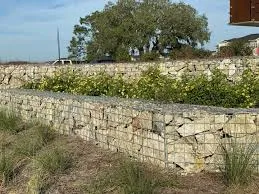-
 Phone:
Phone: -
 Email:
Email:

mesh rock retaining wall
The Advantages of Mesh Rock Retaining Walls
In recent years, the construction industry has seen a growing interest in sustainable and effective solutions for managing soil erosion and stabilizing slopes. Among these innovations, mesh rock retaining walls have emerged as a popular choice due to their practical applications and aesthetic appeal. This article explores the design, advantages, and environmental implications of mesh rock retaining walls.
What is a Mesh Rock Retaining Wall?
A mesh rock retaining wall is a type of structure used to hold back soil and prevent erosion, often employed in landscaping, roadside stabilization, and in areas with steep slopes. Unlike traditional concrete retaining walls, which can be rigid and imposing, mesh rock walls utilize a combination of wire mesh and natural stones, creating a more flexible and visually appealing option.
The design typically involves a sturdy wire mesh structure that is filled with rocks or boulders. This construction method allows for drainage of excess rainwater, decreasing water pressure on the wall and reducing the risk of collapse. The flexibility of mesh walls also accommodates slight shifts in soil movement, helping to minimize damage over time.
Benefits of Mesh Rock Retaining Walls
1. Aesthetic Appeal One of the primary advantages of mesh rock retaining walls is their natural appearance. Unlike concrete walls, which can be stark and unattractive, mesh rock walls blend seamlessly into the landscape. They are often used in gardens, parks, and rural settings where a more organic look is desired.
2. Environmental Impact Mesh rock retaining walls are designed to be more environmentally friendly than traditional options. They promote vegetation growth between the stones, which helps to stabilize the soil further while providing an ecosystem for plants and animals. Additionally, the permeability of the rocks allows water to pass through, reducing runoff and promoting natural drainage.
mesh rock retaining wall

3. Flexibility and Safety The flexibility of mesh rock retaining walls makes them more resilient against earth shifts and movements. In areas prone to landslides or erosion, these walls can adapt better than rigid structures. The design minimizes the risk of sudden wall failure, contributing to the safety of surrounding areas.
4. Cost-Effectiveness Constructing mesh rock retaining walls can be more cost-effective compared to traditional concrete options. The materials used, namely wire mesh and locally sourced rocks, can be more affordable, and the installation process may require less labor due to simpler techniques.
5. Ease of Construction Installing mesh rock retaining walls is often straightforward, requiring basic construction skills. The materials can be delivered and assembled on site, allowing for quicker project completions. Moreover, the walls can be built in various sizes and shapes to suit specific landscape needs.
Applications and Best Practices
Mesh rock retaining walls are suitable for various applications, from residential gardens to commercial sites. However, it is essential to consider soil conditions, slope angles, and local climate when planning a project. Engaging with geotechnical engineers and landscape architects can ensure that the design meets structural and environmental needs.
Moreover, regular maintenance is crucial to ensure the longevity of a mesh rock retaining wall. This may involve checking for displaced stones, assessing plant growth, and ensuring that drainage systems function properly.
Conclusion
Mesh rock retaining walls offer a blend of functionality, aesthetic appeal, and environmental benefits that make them an increasingly popular choice in modern construction. By effectively managing soil erosion and improving landscape integrity, these structures provide a sustainable solution that harmonizes with nature. As awareness of sustainable practices continues to grow, mesh rock retaining walls are likely to play an essential role in landscaping and civil engineering projects for years to come.
-
Wire Mesh for Every Need: A Practical SolutionNewsJul.25,2025
-
Steel Fences: Durable, Secure, and Stylish OptionsNewsJul.25,2025
-
Roll Top Fencing: A Smart Solution for Safety and SecurityNewsJul.25,2025
-
Cattle Farm Fencing Solutions for Maximum SecurityNewsJul.25,2025
-
Affordable Iron Binding Wire SolutionsNewsJul.25,2025
-
Affordable Galvanized Wire SolutionsNewsJul.25,2025
-
Wire Hanger Recycling IdeasNewsJul.25,2025








